Katy's Asia Adventures (plus Mexico!) |
|
|
A haphazard chronicle of my inevitable misadventures during a year in Vietnam and points east. p.s. I'll be pitifully grateful if you send me email during my exile: TravelerKaty@hotmail.com October 2002 November 2002 December 2002 January 2003 February 2003 March 2003 April 2003 May 2003 June 2003 July 2003 August 2003 September 2003 October 2003 November 2003 February 2006 March 2006 May 2006
Archives
|
Tuesday, February 28, 2006
 Day 7 - Part 3 - Moonlight Serenade Day 7 - Part 3 - Moonlight SerenadeOur evening featured live entertainment, a nice departure from our sedate style in which I had to harass people (especially D, a major sleeper) to stay up past ten. Gabriel, a fabulous singer, whistler, and all-around Mexican Cheeseball orignally from Veracruz, put on an excellent show serenading Mom on Dad's behalf with super-romantic Mexican ballads, organizing sing-alongs for the few songs we actually knew (Cielito Lindo, La Cucaracha, and Guantanamera) and liberally peppering other more comic songs with references to "El Juez" (my father's a judge) and his eternal devotion to Mom. Gabriel was awesome, singing directly to each of us, making hilariously appalling coments about the bible confirming that men need many beautiful women simultaneously (I don't think Gabriel is much of a monogamist), and generally exploding with amusing personality and patter. Not to mention he was a beautiful singer. All in all, a great evening. © 2006 Katy Warren (0) comments 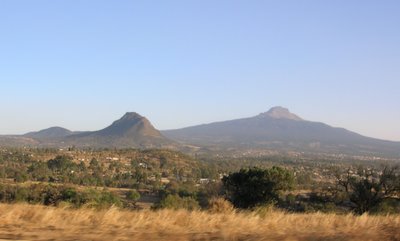 Day 7 - Part 2 - La Malinche Hike Day 7 - Part 2 - La Malinche Hike2/17/06 Cooking and eating completed, D, A and I decided we needed some major exercise, and headed to La Malinche, one of the three nearby volcanoes, with Yair the formerly quiet cab driver. The hike was not exactly what we expected. For one thing, the guidebook, under the "Ecotourism" section, detailed the spectacular ravines, unforgettable panoramic landscapes, and hares and armadillos practically sharing lunch with you. To be honest, we read this description after our trip, and were aware that we were basically just taking a forest hike. We were, however, promised by the long-suffering Yair that when we reached the top of the trail there would be a view of the mountain itself. Like much of Yair's commentary, this prediction turned out to be somewhat fictional. To back up a little, La Malinche, which also has one of those unpronounceable Nahautl names (Matlacueitl), is a dormant volcano about 13,000 feet tall named after the earlier referenced mistress/interpreter of Cortes. Like Tlaxcala, Mexicans have a conflicted view of her -- one article I found was entitled "La Malinche - Harlot or Heroine?". She is considered a traitor to some, having played a central role in enabling Cortes to conquer the Aztecs. At the same time, as the mother of the first mestizo child, she is a symbol of the mix of cultures that Mexico became. Her background, as reported by Cortes' official biographer and other conquistadors (and as a disclaimer, I have no reason to believe they are any less prone to fictionalizing than our cab drivers) was impressively operatic. The only daughter of the lord of Palanya, a region between the Aztec and Mayan empires, she was in line to take control of the province after his death when she fell victim to that age-old dilemma of step-families. Her mother remarried, and she and the Evil Stepfather decided that the new son should be the leader. So to clear the way, they sold or gave the teenaged La Malinche (also known as La Malintzin) to Mayan slave traders. Ah, the good old days, when you could get rid of your obstreperous step-children by selling them into slavery.  She ended up one of the chief's slaves in Tabasco, and along the way learned Mayan. When Cortes arrived on the Yucatan peninsula in 1519, she was one of 20 young slave women given to him by the chief as a result of his conquest of the region. She got her big break when Cortes learned that one of the slave women spoke both Nahuatl, the Aztec language, and Mayan. Thenceforth she served as an interpreter, translating Nahuatl into Mayan, while his other translator, a Spanish priest who had been a prisoner in the Yucatan for years, translated from Mayan into Spanish. She picked up Spanish quickly, however -- by the time they arrived in Tenoctitlan at the end of the year, she was translating directly from Nahuatl without intermediary. She ended up one of the chief's slaves in Tabasco, and along the way learned Mayan. When Cortes arrived on the Yucatan peninsula in 1519, she was one of 20 young slave women given to him by the chief as a result of his conquest of the region. She got her big break when Cortes learned that one of the slave women spoke both Nahuatl, the Aztec language, and Mayan. Thenceforth she served as an interpreter, translating Nahuatl into Mayan, while his other translator, a Spanish priest who had been a prisoner in the Yucatan for years, translated from Mayan into Spanish. She picked up Spanish quickly, however -- by the time they arrived in Tenoctitlan at the end of the year, she was translating directly from Nahuatl without intermediary.The benefit to Cortes of having a reliable translator should not be understated. La Malinche, or 'Dona Marina' as she was known to the Spanish, was born to the role of leader or consort, and served as advisor to both sides in negotiations as well as translator. It is thought by many that the conquest would have been far more bloody and violent but for her efforts. In contemporary art Cortes is rarely shown without her at his side, and she is also shown on her own, independently directing events. The two were considered a ruling unit by many natives, rather than conqueror and interpreter, and La Malinche remains a central and controversial figure in Mexican history and culture.  But enough of the historical digression! After a generous double-application of A's Incredibly Expensive Banana Boat, our hike began at La Malintzi Vacation Center, a "family recreation paradise with all the attractions and comfort needed for endless entertainment". [Further digression: words can't describe how much I love the "Tlaxcala Loves You" tourist guide provided by Jon and Estela. Any guidebook that can describe Tlaxcala as an "aquatic paradise" because of its single lake (complete with "Apache Fort" for the kids!) earns my Hyperbolic Copywriter Seal of Approval. ] The LMVC services, I can report first hand, included cabins, basketball court upon which people play soccer, kids play area, and a parking lot with what would be a very nice view of La Malinche if they hadn't erected two cell phone towers right in the middle of the view. But enough of the historical digression! After a generous double-application of A's Incredibly Expensive Banana Boat, our hike began at La Malintzi Vacation Center, a "family recreation paradise with all the attractions and comfort needed for endless entertainment". [Further digression: words can't describe how much I love the "Tlaxcala Loves You" tourist guide provided by Jon and Estela. Any guidebook that can describe Tlaxcala as an "aquatic paradise" because of its single lake (complete with "Apache Fort" for the kids!) earns my Hyperbolic Copywriter Seal of Approval. ] The LMVC services, I can report first hand, included cabins, basketball court upon which people play soccer, kids play area, and a parking lot with what would be a very nice view of La Malinche if they hadn't erected two cell phone towers right in the middle of the view.Yair, a roly-poly gentleman with inappropriate shoes and the air of a man who prefers wheeled transportation, assured us that he had climbed the mountain before and very much surprised us by insisting on joining the hike. Sadly for him, he seems to have volunteered under the misapprehension that we were like other more feeble ladies he had taken to Malinche, who would take a leisurely 30 minute stroll in the forest and turn back for a refresco and a bit of shopping. We, however, had spent the previous afternoon in the car and were in the mood for some strenuous exercise, and thus set a pace that had Yair panting and all of us feeling the altitude.  Not being the adventurous sort, Yair guided us along a paved road that switchbacked up the mountains for about 5 km to a phone tower. He had never taken the well-trodden trails leading into the forest, and indeed had informed us that people lived up those trails in little houses. Clearly "I don't know" is not an acceptable answer to a direct question to a Mexican driver/guide. After 40 minutes of uphill we took a rather longer rest than usual. At this point we were thinking about turning back, or maybe walking another 20 minutes then returning. It was all forest, after all, with no view to speak of and mostly paved road apart from the times we ignored Yair and took off on one of the forest paths. It was a very nice forest walk, don't get me wrong, with aromatic pines and just enough breeze to make it pleasant. Of course, the Banana Boat wasn't getting too much of a workout, but at our power pace we certainly were. Not being the adventurous sort, Yair guided us along a paved road that switchbacked up the mountains for about 5 km to a phone tower. He had never taken the well-trodden trails leading into the forest, and indeed had informed us that people lived up those trails in little houses. Clearly "I don't know" is not an acceptable answer to a direct question to a Mexican driver/guide. After 40 minutes of uphill we took a rather longer rest than usual. At this point we were thinking about turning back, or maybe walking another 20 minutes then returning. It was all forest, after all, with no view to speak of and mostly paved road apart from the times we ignored Yair and took off on one of the forest paths. It was a very nice forest walk, don't get me wrong, with aromatic pines and just enough breeze to make it pleasant. Of course, the Banana Boat wasn't getting too much of a workout, but at our power pace we certainly were.This was the point at which Yair, who was already trailing behind, made his Critical Male Error. When asked whether most tourists made it to the top, he guilelessly replied that usually the men made it to the top and the women waited half-way up. Well. We knew a challenge when we heard it -- it was obviously our responsibility to stand for the Power of Womanhood. No longer would Yair be able to say that only men made it to the end of the trail.  And so we continued up. And up. And up. Seriously, that hike had to be more than 6 km. In the end, we left Yair on the side of the trail and continued to the end, only to discover that it ended in a thick forest well before the mountain was visible. We would need to blaze our own trail to get over the next rise, and at that point our situation was so uncertain (would there really be a view from up there?) that we couldn't summon much energy for it. After snacks (thanks, Mom!) and a photo op we headed back down, and since I was in the lead this time (I'm much better at down than up) I took every little woodsy path available to keep us off the paved road. Yair, delighted to learn all these new paths (despite the fact that we now knew how full of hooey the "little houses" story was), told D that he should offer me a job as his new guide. Mom and Dad should be pleased that I have so many and varied employment opportunities. And so we continued up. And up. And up. Seriously, that hike had to be more than 6 km. In the end, we left Yair on the side of the trail and continued to the end, only to discover that it ended in a thick forest well before the mountain was visible. We would need to blaze our own trail to get over the next rise, and at that point our situation was so uncertain (would there really be a view from up there?) that we couldn't summon much energy for it. After snacks (thanks, Mom!) and a photo op we headed back down, and since I was in the lead this time (I'm much better at down than up) I took every little woodsy path available to keep us off the paved road. Yair, delighted to learn all these new paths (despite the fact that we now knew how full of hooey the "little houses" story was), told D that he should offer me a job as his new guide. Mom and Dad should be pleased that I have so many and varied employment opportunities.Pleasantly exhausted, we headed back to the house. It was a delightful drive, due to the unfortunate (to others) accident on the highway forcing us to detour through a serious of picturesque little villages between the volcano and Tlaxcala city. And even though we didn't get much of a view on our hike, at least we burned off enough calories to justify those strong margaritas and deep fried dinner. © 2006 Katy Warren (0) comments  Day 7 - Part 1 - Mexican Home Cooking School Day 7 - Part 1 - Mexican Home Cooking School2/17/06 Without further ado, here's a summary of cooking class: Sopa de Tortillas (tortilla soup). This is a bit of a Mexican official dish. For the most part it's a tomato soup with garlic, onions, and serrano chiles, and its final presentation is supposed to evoke the Mexician flag -- red in the soup, white sour cream and cotija cheese sprinkled on top, and green avocado slices and fresh cilantro for garnish. Crispy dried corn tortilla chips are generously mixed in. Not Doritos. Real tortilla chips. That's what actual cooks use. Filete de Sierra en Adobo (whitefish filet in Adobo sauce). I was happy to learn that this Adobo sauce is also good on rabbit, since I do a great deal of cooking with small furry animals. Adobo sauce, a very yummy thing, has lots of chiles, garlic, oregano, cumin, etc. I have no further comment and have determined that I can never become a food writer.  Chiles Rellenos and Chiles en Nogada (stuffed chiles with walnut sauce). Both the stuffed poblano chile dishes involved the usual pain-in-the-ass chile prep of cutting and de-seeding, charring over open flame or "comal", cool and peel. I love stuffed chiles, but as Estela says this is not an everyday exercise. These dishes were also both fried with flower and egg coating, giving them a look of tempura. Chiles Rellenos and Chiles en Nogada (stuffed chiles with walnut sauce). Both the stuffed poblano chile dishes involved the usual pain-in-the-ass chile prep of cutting and de-seeding, charring over open flame or "comal", cool and peel. I love stuffed chiles, but as Estela says this is not an everyday exercise. These dishes were also both fried with flower and egg coating, giving them a look of tempura.The traditional chiles rellenos were the easiest -- stuff them with cheese and toothpick the sides closed, then drop the battered chiles into the hot oil (they'd love the fry-daddy down there). Pour a little home-made tomato sauce over the top and you're good to go.  The second recipe, Chiles en Nogada, was slightly more complicated, involving a stuffing mixture of pieces of fruit, raisins, almonds, garlic (as usual) and ground beef. The chile was then battered, fried, and topped by a delicious walnut (or pecan) sauce. Very very good, and not something I'd tried before. The second recipe, Chiles en Nogada, was slightly more complicated, involving a stuffing mixture of pieces of fruit, raisins, almonds, garlic (as usual) and ground beef. The chile was then battered, fried, and topped by a delicious walnut (or pecan) sauce. Very very good, and not something I'd tried before.© 2006 Katy Warren (0) comments Monday, February 27, 2006
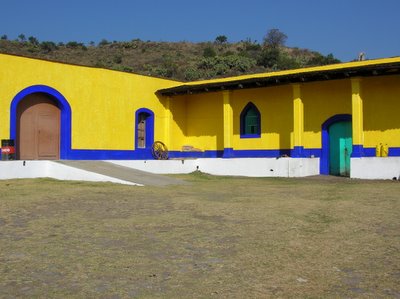 Day 6 - Part 3 - Pulque-making Hacienda & Tlaxco Day 6 - Part 3 - Pulque-making Hacienda & Tlaxco2/16/07 The purpose of our second Hacienda of the day, located near Tlaxco in the far northern part of Tlaxcala state, was the production of pulque, the revolting fermented cactus juice, in the traditional way. The hacienda structure was a far cry from the traditional Mexican/Spanish elegance of La Laguna. This was more of a mini-brewery in a traditional (if very colorful) adobe building, surrounded by high walls. The living areas were not visible from where we were, and the walled area was strewn with crumbling bricks and rusty farm implements and vehicles. This walled area was surrounded by fields of maguey, the cactus (or agave, according to the nitpickers over at Wikipedia) from which the raw "honey water" is harvested. Mezcal and tequila are also made from this plant, though the latter seem to be made from the heart of the maguey rather than just its juice. Luck continued to be with us -- on our way up the drive we happened upon a ranch worker in the process of siphoning out the juice from a large maguey, using a bright blue fiberglass device shaped like a rounded, oversized horn. He would stick the smaller end into the center of the cactus where a bowl had been created, scrape out the excess vegetable matter, then suck on a hole in the round end of the horn. After plugging the smaller hole at the bottom, he would walk over to his burrow and empty the liquid into one of his two barrels. The worker was very friendly and helpful, particularly considering he reportedly got paid by how much he could harvest during the day, and we were pretty much burning up his time. The pulqueria itself was a bit lacking in food production hygiene standards, though I guess the fermentation process may vanquish all ills. The smell when the doors were opened damned near knocked us over. Fermentation apparently smells similar the world over - we felt like we were in a particularly poorly ventilated brewery. At one end was a festive shrine to the Virgin (patron saint of booze?) and the rest was lined with vats of various types, fiberglass, cowhide (still furry!) and wood, in which the maguey juice was placed at various points in the month-long fermentation process. Pulque was once the alcoholic beverage of choice in Mexico, indeed it has been around for a thousand years. Ruben reported that his grandmother drank it every day and lived to the age of 92 in perfect health. But World War II, and the return of soldiers who had developed a taste for beer, eventually put paid to the age of pulque. Now beer is the predominant beverage, and pulque, which is difficult to store and preserve, is very much on the wane.  The hacendado of the pulque hacienda could not have been a greater contrast to The Mustache. We waited around for ten minutes before one of the workers clued us in that the grizzled geezer in the cowboy hat leaning against the pickup was not an elderly farmhand but the owner of the establishment. He clearly needed attitude and costume tips from his opposite number at La Laguna. The hacendado of the pulque hacienda could not have been a greater contrast to The Mustache. We waited around for ten minutes before one of the workers clued us in that the grizzled geezer in the cowboy hat leaning against the pickup was not an elderly farmhand but the owner of the establishment. He clearly needed attitude and costume tips from his opposite number at La Laguna.We did, of course, try the pulque in both its raw honey water and fermented forms. Straight out of the maguey it was sweet and mostly tasteless. Fermented it was sweet and mostly revolting, with the added detriment of being a bit stringy. A and D immediately re-thought their plans to bring some pulque back to their husbands. The remainder of the day was punctuated by aborted efforts -- we were unable to find the lady who sold silver out of her house in Tlaxco, any open restaurants on the Tlaxco plaza, or a useful pharmacy. On the more successful side, we got the GSM celle phone to work finally (it helps to use the correct prefixes when making your calls) and we visited the Gigante supermarket, at which I marveled at the vast amount of cooking oil and A purchased the most expensive tube of Banana Boat sunblock in North America. Pulque Harvesting:  Scrape out the middle and suck out the juice. Scrape out the middle and suck out the juice.  Pulque of the future. Pulque of the future.  Hold the bottom of the blue horn closed -- don't want to have sucked in vain. Hold the bottom of the blue horn closed -- don't want to have sucked in vain.  Off to the next plant. Off to the next plant. Pulqueria:  What, doesn't your distillery have it's own altar? What, doesn't your distillery have it's own altar?  Mmmm, stringy foamy liquid that's been soaking in a hairy cow for a month. Who wouldn't love pulque? Mmmm, stringy foamy liquid that's been soaking in a hairy cow for a month. Who wouldn't love pulque?  Tasting time. A's facial expression says it all. Tasting time. A's facial expression says it all.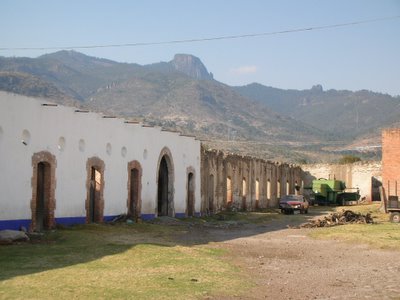 Do you see what I mean about the debris and old farm equipment? Do you see what I mean about the debris and old farm equipment? The Mustache would never tolerate it at his place. Tlaxco:  Is it just me or is this church a little unbalanced? Is it just me or is this church a little unbalanced? I took this photo especially for my aunt Carolyn who is an anti-smoking crusader. This is a sign in the Tlaxco zocalo that says: "Smoking causes emphysema. Take care of your health" I took this photo especially for my aunt Carolyn who is an anti-smoking crusader. This is a sign in the Tlaxco zocalo that says: "Smoking causes emphysema. Take care of your health" And if any Tlaxcoans choose to continue smoking, And if any Tlaxcoans choose to continue smoking,just around the corner there's a 24-hour funeral parlor. © 2006 Katy Warren (0) comments 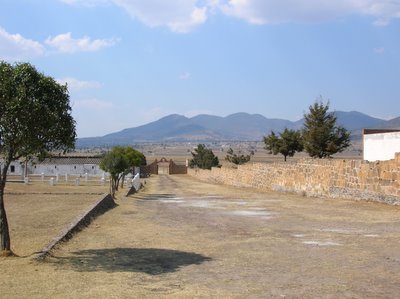 Day 6 - Part 2 - Hacienda La Laguna Day 6 - Part 2 - Hacienda La Laguna2/16/06 I'm getting a reputation as quite a talker in my family. Actually more of an interrogator, to be honest. There is a confluence of issues here -- I am intensely curious about people's lives, culture, government, hometown, pets, whatever, so I will take almost any opportunity to grill a willing victim, be it cab driver or passerby. At the same time, I have a look about me that I would describe as Utterly Harmless, which means that it is not at all unusual for strangers to ask me for directions or strike up a random conversation. Indeed, I have learned that even to emit the strongest back-the-hell-off vibes, as when I am in a bus simultaneously reading a book, listening to a walkman and spreading my bags over the adjoining seat, people will still attempt to engage me in idle (or insane, depending on the mental health of my new seatmate) chit-chat. Because of this well-known propensity, it was not surprising that our morning walk was slightly derailed as a woman down the road waylaid me with five minutes of curious questions. Nor was it unexpected that I eventually hogged the front seat of our van during our afternoon outing, unable to contain myself from attacking Ruben, our jolly driver, shotgun style with questions ranging from Mexican telenovelas to the probable outcome of the upcoming national elections to the legality of betting on cockfights. Fortunately for me, the trip was six hours long and the driver was basically captive; fortunately for Ruben and my family, I ran out of questions and conversation after about four hours. Our afternoon tour took us much farther afield than our previous jaunts. Through Jon we arranged to have chatty Ruben take us to the northern part of Tlaxcala state to check out a couple of haciendas. And Ruben had a van! No more smooshing 4 passengers into the japanese compact taxicab! It was obvious from the outset that we were to be the guinea pigs for a future mini-business in Hacienda Tours. We were warned by Ruben that the hacendados didn't know we were coming, and that if we couldn't get into the first ones he had several others to choose from. As it turned out, apart from a few wrong turns quickly corrected (generally be the use of mid-street U-turns) all went exactly planned with no alternate sites required. Ruben was thrilled at our luck and success at his first Hacienda Tour attempt, as were we.  Haciendas were not just where the very rich lived back in the day. During the 17th, 18th and into the 19th century they were the very core of the economy of Tlaxcala state and most of the Spanish colonial empire in America. They were mostly self-sufficient and served as mini-villages with possibly hundreds of workers and their families residing on the property and raising food, animals, pulque, and even conducting full mining operations in some areas of Mexico. Workers at plantations (called peones), were effectively treated as slaves. They could be sold, their daughters could be taken for whatever purposes the hacendado had in mind, etc. Today, after numerous revolutions (particulary the final one of 1910) and land reforms, most of the haciendas have been broken up, though the the cattle-breeding haciendas were allowed to survuve under special certificates signed by the new Mexican president. Those dominated by agriculture and pulque production were less lucky - most were sold off in parts after the 1917 land reform. Haciendas were not just where the very rich lived back in the day. During the 17th, 18th and into the 19th century they were the very core of the economy of Tlaxcala state and most of the Spanish colonial empire in America. They were mostly self-sufficient and served as mini-villages with possibly hundreds of workers and their families residing on the property and raising food, animals, pulque, and even conducting full mining operations in some areas of Mexico. Workers at plantations (called peones), were effectively treated as slaves. They could be sold, their daughters could be taken for whatever purposes the hacendado had in mind, etc. Today, after numerous revolutions (particulary the final one of 1910) and land reforms, most of the haciendas have been broken up, though the the cattle-breeding haciendas were allowed to survuve under special certificates signed by the new Mexican president. Those dominated by agriculture and pulque production were less lucky - most were sold off in parts after the 1917 land reform.As an aside, when we first met Ruben he (as a result of my usual interrogation as to his antecedents) told me a colorful tale of his ancestors. His grandfather (probably great or great-great) was the owner of a hacienda, and in 1910 had just married Ruben's grandmother, a 15-year-old from another great family who was expecting their first child. When the Zapatistas came, his grandparents begged them to let them go unharmed. The leader relented, saying that if he saw them again he would kill them and anyone else around them. So the two of them and their family packed up in the dead of night, filled a belt with all the gold and money they could get their hands on, and fled to Puebla, never to return to the Hacienda. They ended up having 9 children and living out their lives in Puebla. Great story, eh? Let's just decide to suspend our critical faculties and believe it all, for Ruben's sake. Cattle breeding, fighting bulls to be specific, was the primary occupation of our first hacienda, La Laguna. Since we were completely uninvited, permission to see the place was our first order of business. We all piled out of the van, Ruben being of the opinion that our presence would exert a powerful pressure on the hacendado to allow us to walk around . As it happens, I would not have missed meeting this guy for anything. Very much of the quien-es-mas-macho variety of Mexican male, the owner, an engineer by trade, exuded superiority from every pore. Dressed in a skintight red Ferrari sweatshirt and figure-hugging black pants, his attitude indicated that this was what the Conquistadors should have been wearing. The mustache, however, was his crowning glory. Such full, flowing, dramatic mustaches could be enclosed in glass cases and displayed in museums with captions such as "Symbol of the Glorious Conquest of Mexico." Sadly, I was too chicken to ask for a photo. Even I, who had seemingly taken thousands of photos already, was intimidated by The Mustache (or El Bigote in espanol).   On the left - an artist's rendering of our Hacendado if he were a low-rent Mexican cowboy actor. The mustache is a little weak, but the attitude is spot on. On the left - an artist's rendering of our Hacendado if he were a low-rent Mexican cowboy actor. The mustache is a little weak, but the attitude is spot on. On the right - General Ambrose Burnside, who lacks the proper I-tolerate-the-little-people aura but whose mustache is a fairly close approximation. The good news was that even though we interrupted his lunch, The Mustache was very accomodating, dispatching his minion Hector, AKA the ranch manager, to show us around. I rather thought we inturrupted Hector's siesta, but he was nothing but helpful and friendly, submitting genially to my usual raft of questions, this time mostly about raising and fighting bulls.  In addition to cattle raising, which is apparently not an extremely lucrative proposition these days (hence The Mustache's day job), La Laguna also had a thriving business in large and small scale parties in the courtyards, and also rented out five of its rooms as a bed-and-breakfast. I would have to think they must offer more of a bread-and- breakfast- and-lunch- and-dinner given how far off the main road it is. The nearest town was the very accurately named "Ciudad Industrial," which appeared to consist of about 20 factories, a very overdesigned road system, and virtually no residential or commercial offerings. In addition to cattle raising, which is apparently not an extremely lucrative proposition these days (hence The Mustache's day job), La Laguna also had a thriving business in large and small scale parties in the courtyards, and also rented out five of its rooms as a bed-and-breakfast. I would have to think they must offer more of a bread-and- breakfast- and-lunch- and-dinner given how far off the main road it is. The nearest town was the very accurately named "Ciudad Industrial," which appeared to consist of about 20 factories, a very overdesigned road system, and virtually no residential or commercial offerings.The rooms were very high ceilinged, with the usual gorgeous round fireplaces built into one corner and a decorative cow hide covering most of the tile flor at the foot of the bed. all the rooms opened onto a walkway around the large courtyard (complete with giant party tent in preparation for the 500 guests attending a baptism the following weekend). The tiled walkway was lined with wooden benches, framed corrida posters and huge bull heads. These were Los Machos - the bulls that after a distinguished fighting career (which consists of one fight, not to the death, in the Mexican version of bullfighting), their ears were cut off and presented to the torero and the bull was sent back home to La Laguna to provide years of stud services. This little article gives more info about raising and fighting bulls in Mexico, and even has a nice mention about La Laguna: Today, the State of Tlaxcala has the largest number of bull breeding ranches or ganaderias–a total of 40, followed by the States of Guanajuato and Jalisco. The premier ranch is Ganaderia La Laguna de Terrenate, founded in 1908 by Don Romareo Gonzalez, with cows from Tepeyahualco and a breeding bull from Ibarra. It has had more winners at the Plaza Mexico in Mexico City–23 to date–than any other breeding ranch in Mexico.Good choice, Ruben! 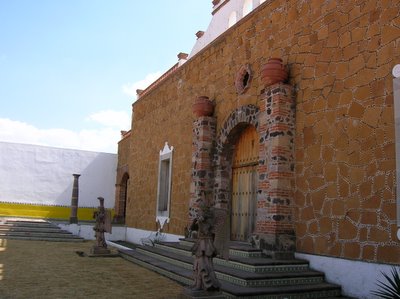 A modest little chapel for 70 (right) or so was located at one end of the courtyard, with a simple white interior, dark paintings and a couple of very old statues. At the other end, a living area with conversationally placed plush couches was provided for guests and an airy tiled kitchen with a modern cow theme contrasted with the more formal dining room with its heavy wood furniture and large round table. A modest little chapel for 70 (right) or so was located at one end of the courtyard, with a simple white interior, dark paintings and a couple of very old statues. At the other end, a living area with conversationally placed plush couches was provided for guests and an airy tiled kitchen with a modern cow theme contrasted with the more formal dining room with its heavy wood furniture and large round table.Outside, the bull testing ring adjoined the main Spanish-style stone building. While The Mustache and others watch from the little bandstand, young bulls would be brought into the ring. The torero, already positioned inside the ring, will make a few passes to see how the bull reacts, then the picador on the horse gets a shot at it. Bulls that run the other way are destined for the dinner table. Feistier bulls who lack horns that point forward might end up in festivals and novice corridas for younger bulls and bullfighters, while those with both temperament, looks, and suitably dangerous horns will continue to live a life of leisure on the ranch until they are tapped to fight at around age four. Bulls that put up a good fight and showcase the torero's valor and talent to good effect will have an ear or two removed and presented to the torero with great ceremony. These bulls will return to the ganaderia with more chance of a life of servicing cows and less chance of becoming carne asada. Some of these successful bulls are sold to other ganaderias as breeding animals as well.  The countryside is desert-like, with dry hills all around and various varieties of cacti and scrub. To get to the bulls themselves we rolled over dirt tracks even worse than the road to the hacienda, and through a security system consisting of a series of barbed-wire gates. One would not wish for an unexpected encounter with a free-ranging fighting bull. Each herd of bulls contained one "Macho" and about 20-40 younger upstarts, including one calf just 10 days old. We stayed in the van and took photos through closed windows. No need to become a Stupid Tourist Tragedy. Although they were small -- Mexican fighting bulls are smaller than their Spanish counterparts and smaller still than American rodeo bulls -- they still looked pretty ticked off and I would not relish those horns and that personality betwen me and the safety of the vehicle. The countryside is desert-like, with dry hills all around and various varieties of cacti and scrub. To get to the bulls themselves we rolled over dirt tracks even worse than the road to the hacienda, and through a security system consisting of a series of barbed-wire gates. One would not wish for an unexpected encounter with a free-ranging fighting bull. Each herd of bulls contained one "Macho" and about 20-40 younger upstarts, including one calf just 10 days old. We stayed in the van and took photos through closed windows. No need to become a Stupid Tourist Tragedy. Although they were small -- Mexican fighting bulls are smaller than their Spanish counterparts and smaller still than American rodeo bulls -- they still looked pretty ticked off and I would not relish those horns and that personality betwen me and the safety of the vehicle.After a final Audience with The Mustache, in which more kisses and profuse thank yous were exchanged, we turned north again, only briefly getting turned around in the inexplicable maze-like Ciudad Industrial. Next stop - Hacienda #2, a considerably more down-at-heel example, to be discussed in Part 3. More photos:  View from the grandstand as Ruben makes like a torero in the practice ring. View from the grandstand as Ruben makes like a torero in the practice ring. Walkway around the courtyard leading into Chapel. Walkway around the courtyard leading into Chapel. Might as well make use of the whole bull. Might as well make use of the whole bull. Toro! Toro! Toro! Toro! Toro! Toro!© 2006 Katy Warren (0) comments  Day 6 - Part 1 - Mexican Home Cooking School Day 6 - Part 1 - Mexican Home Cooking School2/16/06 Another morning cooking class! I will note that at this point we had spent nine full hours cooking, probably as much time as I usually spend in any given year, as long as I'm not required to count the 1 1/2 minutes per morning of Cheerio prep. And as for all the chopping and peeling and whatnot, well, I don't know when such dramatic actions have last occurred in my kitchen. Perhaps when guests were visiting. Suffice it to say, the week was highly educational, and Estela hoped it was inspirational as well. We shall see. By the way, I think those things in the picture above are nopales in their semi-natural cultivated habitat. First time I've see a cactus farm, that's for sure. There's really only so much I can say about cooking class. It was always interesting and fun, but on Day 4 I'm starting to run out of things to write about it. So I'll just run down the menu with commentary:  Cream of Poblano Chile Soup. We had such delicious soups every day that we could easily come to blows over which one was the tastiest. This Day 4 soup was definitely in my top 4. Cream of Poblano Chile Soup. We had such delicious soups every day that we could easily come to blows over which one was the tastiest. This Day 4 soup was definitely in my top 4.Frijoles Negros (black beans). This recipe, while simple, was substantially more time consuming than getting them out of the can. Plus it required that that you soak them the night before. The night before! I ask you! That kind of planning requirement means that I will never make these in real life, no matter how good they were. And they were very good. Chipotles en Conserva (canned chipotles). Whooooweee, was this ever spicy! Even mixed with Philadelphia cream cheese and stuck on a tortilla chip it about peeled the top of my mouth off. I guess if you make something with 10 dried chipotles and 4 cloves of garlic you should expect a little heat. Note to self: mix this with lots of very bland food. the recipe says you can use it as a topping for quesadillas, crackers with ricotta, potatoes with chees, fried beans and cheese, etc. All I can say is: Proceed with Caution. Tinga (shredded skirt steak). here was an example of being able to tone down the chipotle stuff by using it in a recipe. We ended up eating this mixture of shredded steak, chipotles en conserva, garlic, tomatoes, onion and spices on top of "sopes" with lettuce, sour cream and cheese like a mini-tostada. Yummy. Pipian Rojo (called Red Mole in Oaxaca) with pork was our dinner meal. It was delicious, a bit too spicy for Mom but I think it's a good candidate for A, who can double the chiles and try to blow her husband's head off. He's a bit demented on the spice f ood front - if his eyes aren't watering and nose running it's not sufficiently spicy. My only problem with the recip is that it has 15 ingredients. 15!!  Sopes are fat little mini-tortillas with edges crimped up so you can stick stuff inside, usually beans, guacamole, cheese, etc. They can also be deep-fried, which improves everything of course. When I lived in Veracruz for a summer way back in the day, we would have sopes with spicy green stuff on top most mornings for breakfast. Sopes are fat little mini-tortillas with edges crimped up so you can stick stuff inside, usually beans, guacamole, cheese, etc. They can also be deep-fried, which improves everything of course. When I lived in Veracruz for a summer way back in the day, we would have sopes with spicy green stuff on top most mornings for breakfast.Guacamole. Like the salsa, we made guacamole with mortar and pestle (probably won't happen in my food-processor world). John assured us, however, that it tastes much better when done this way. It was, indeed, very tasty and with a better consistency than a lot of guacamole. As mentioned earlier, it used tomatillos and did not use lemons - Estela sprinkled olive oil over the top to keep it from turning brown. More photos:  This is where Estela tells Jon how things are done in her kitchen. 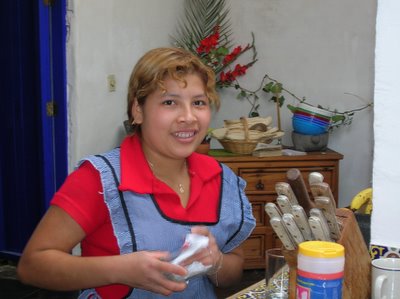 This is cute little Maria, the maid, kitchen helper, etc.  Max likes cooking class too. © 2006 Katy Warren (0) comments Sunday, February 26, 2006
Photo Essay - D the Firestarter Early on, D was designated our chief firemaker. This was due to her self-reported 11 years of training. It can get very cold at night in Tlaxcala -- it was February in the mountains at 7500 feet above sea level, after all -- so her services were very much in demand. Unfortunately it appears that her training was not as hands-on as we might have wished. It may, in fact, have involved her husband G building the fires and feeding out bits of useful information that weren't entirely digested. After the first failed effort, however, she definitely got the hang of it, and it seems that fire maintenance requires constant vigilance and frequent adjustments and additions. I attempted to stay as far as possible away from this process, as I am aware that when it comes to practical tasks like this, I have the attention span of a five year old on a pixie stix diet. I do have other strengths, of course, like providing amusing commentary and tripping over things.  First you light the fire. 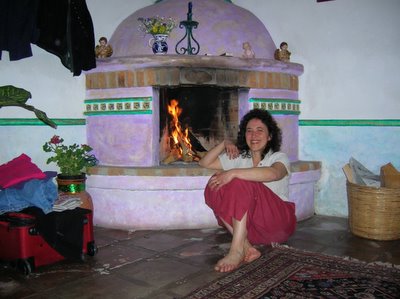 Success! D's training came through!  Oops, fire went out after 5 minutes. Lets try again.  Plan B - get Maria to help. © 2006 Katy Warren (0) comments  Day 5 - Part 2 - Cacaxtla & Xochitecatl Ruins Day 5 - Part 2 - Cacaxtla & Xochitecatl Ruins2/15/06 One of the reasons I was very enthused about traveling to this off-the-track corner of Mexico was that Dad assured me that in addition to learning to cook ,there were very interesting pre-Hispanic ruins in the area. Well, that was one reason -- actually any travel plan is like crack to me, I just can't get enough, but the ruins were a very nice bonus since I'm kind of a nut for ruins of all cultures. At any rate, Wednesday was our Day of Ruins. There were two major sites near Tlaxcala, Cacaxtla and Xochitecatl, (referred to exclusively as "C" and "X" in our conversations, much to the amusement of our cabbie) located on adjacent hilltops about a half a mile from each other. Though some guide books report that the Archaeological Zone is 11 km from Tlaxcala, we either took the long route or that was a crow-flies kind of estimate. There were no crows flying along our route, that's for certain. A more accurate estimate of the distance is about 24 km, and they are slow, if interesting, kilometers through lots of little pueblos chock full of uniformed schoolkids, churches, burros, and muffler shops. Several looked to have had recent town celebrations, but the more likely scenario given the general love of festivals around here is that they leave the decorations up year around. Even in our countryside retreat at the MHCS we still heard firecrackers almost every day. In addition to the natural delaying effect of three-legged dogs, people wandering into the road, tractors, and drunken bicyclists, Mexican roadbuilders have solved the crazy-speeding-driver syndrome that I had witnessed on previous trips to Mexico by installing very aggressive speed bumps at irregular intervals. And it's not just that they are enormous (indeed, our little overloaded taxi slowed to a crawl and approached some of them diagonally so as not to bottom out), they are also virtually invisible, many are unmarked either by warning signs or yellow paint. I can only imagine what it's like to drive these roads at night. Though it surely would have been an adventure, I was a bit relieved once again that we had decided not to rent a car. I could easily picture us inching along, craning our eyes for the next "tope", slamming the brakes for every three-legged dog and so afraid to pass that we ended up traveling behind a tractor for 10 miles while elderly men on rusty bicycles passed us by. 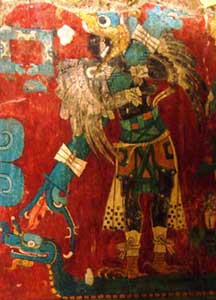 Our first stop, Cacaxtla, was only discovered by archaeologists during the 1970's. A government, trade and religious capital of the Cacaxtli (thought to be an Olmeca-Xicalanca people), about whom scholars and cab drivers seem to know little, the city served as a crossroads between civilizations all around Mexico. The temple and palace complex atop the hill offers impressive colorful murals with Teotihuacan, Maya and Nahuatl influences. Images include detailed battle scenes, complete with a "Find the Sacrificed Warrior!" game for the kids, and Teotihuacan-style animals and humanesque figures depicting Quetzalcoatl, the feathered snake god, and Xolotl, his twin the evening star god. Our first stop, Cacaxtla, was only discovered by archaeologists during the 1970's. A government, trade and religious capital of the Cacaxtli (thought to be an Olmeca-Xicalanca people), about whom scholars and cab drivers seem to know little, the city served as a crossroads between civilizations all around Mexico. The temple and palace complex atop the hill offers impressive colorful murals with Teotihuacan, Maya and Nahuatl influences. Images include detailed battle scenes, complete with a "Find the Sacrificed Warrior!" game for the kids, and Teotihuacan-style animals and humanesque figures depicting Quetzalcoatl, the feathered snake god, and Xolotl, his twin the evening star god.On a Wednesday afternoon we were the only ones around, apart from a friendly Mexican couple celebrating their 31st anniversary, though I learned from the gift shop ladies that Sundays are free admission and thus very crowded. It was definitely worth shelling out the $4 to have the place to ourselves. The museum was great too, with a collection of artifacts found on the site, including some very fine decorative wall carvings. I have only one caveat in recommending a visit to Cacaxtla -- if you get a drink in the little restaurant, just stick to Coke or OJ. D ended up with two different bottled fruit drinks that were undrinkable for one reason or another (weirdly smelly, for example). After the semi-refreshing drink and a rather lengthy and productive trip to the gift shop, we packed ourselves Ringling-Brothers style back into our mini-taxi and headed to the next hill, a small extinct volcano called Xochitecatl upon which are perched three small ceremonial pyramids used for worship between 800 BCE to 900 AD. At this point I am reminded by Mom that she "climbed up two mountains" during our afternoon of ruins. Confidentially, we were most of the way up when the respective walks started, but there was indeed uphill hiking involved, as well as precarious stairs, and she kept up with us just fine. So here's to Mom, putting up with our activity plan without complaint and with and acceptable degree of (feigned?) enthusiasm. 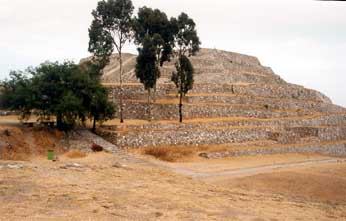 Once we reached the top of the hill, however, her enthusiasm did wane somewhat, and as she spotted a cunningly placed bench under a shade tree that appeared to be calling out for a woman with a book. Thus the four of us climbed the smallest 'Snake Pyramid' together, and mom luxuriated in the shade while the three sisters climbed the others. Once we reached the top of the hill, however, her enthusiasm did wane somewhat, and as she spotted a cunningly placed bench under a shade tree that appeared to be calling out for a woman with a book. Thus the four of us climbed the smallest 'Snake Pyramid' together, and mom luxuriated in the shade while the three sisters climbed the others.The Pyramid of Flowers, the largest of the three, was built with a grand staircase, two water altars and several tiers leading up to a lovely panoramic view of the three volcanoes. The Spiral Pyramid was to me the most interesting. . It was probably dedicated to Ehecatl, the god of the wind, and was built with no stairs in a unique spiral shape so that worshippers would climb around and around to reach the top. Naturally as this is Mexico, a large cross has been placed on top, which looked a bit anachronistic, but which wasn't completely unexpected. All in all it was a great day -- we saw some interesting ruins, climbed things, and hopefully got enough of a suntan that our friends and coworkers would be envious when we returned to sub-zero temperatures. More photos of Cacaxtla and Xochitecatl:  The ruined palace of Cacaxtla with its massive protective roof - The ruined palace of Cacaxtla with its massive protective roof -note the hordes of tourists we had to dodge.   OK, do you see what's wrong with these pictures? On the left is a shot from the "Xochitecatl . . . fertility shrine of Tlaxcala" section of my fancy "Tlaxcala Loves You" tourist guide. That Stonehenge thing is impressively huge, no? On the right is me, on top of the Pyramid of the Flowers, touching the actual Stonehenge thing. It's a total guidebook bait and switch! This thing is practically Spinal Tap size -- I fully expected dwarves to come dancing around at any moment.  Stairwell up the Pyramid of Flowers. Stairwell up the Pyramid of Flowers. This technique of building walls with rock and then decorating the mortar between them with little individually placed rocks is seen in buildings all over the region.  See the resemblance? I knew I had Olmeca-Xicalanca roots. See the resemblance? I knew I had Olmeca-Xicalanca roots.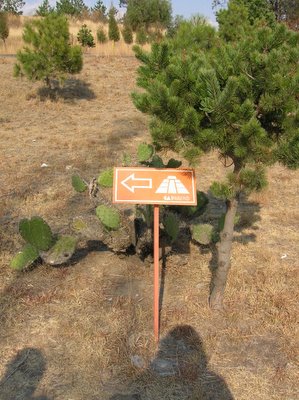 I love this sign - so simple, so informative! I love this sign - so simple, so informative!© 2006 Katy Warren (0) comments |

